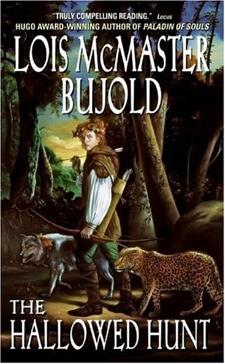The first time I read The Hallowed Hunt it was not the book I was looking for and I was disappointed in it. It’s set in the same world as The Curse of Chalion (post) and The Paladin of Souls (post). But while it’s the same world and the same gods, it’s set in another part of the world, Chalion is barely mentioned and it has no overlapping characters. It may (by analogy to our history) be set hundreds of years before the other books, there’s no internal way of telling. These books are each stories of one of the gods, and this is the book of the Son of Autumn, god of hunting and fighting and young men. The first two books feature demons, this one has entangled animal souls. It also has much more conventional chacters—Cazaril and Ista are older people who have failed at their early careers and are making mid-life changes, but here we have two young people. We’re given time to learn about Chalion before it is at stake, here we’re thrust into the Weald and not given time or reason to care about it. There are some wonderful moments here, but even coming back to it now knowing what to expect I think it’s a weaker book than the others.
Ingrey is a man whose father bound a wolf-soul to his when he was a teenager. This is illegal and heretical, but he has been allowed to live because he was a victim, not a perpetrator. When he dies, he will be permanently dead, because his soul is contaminated. While he lives he works as a troubleshooter for Hetwar, a royal advisor. As the book begins, he is sent to investigate the death of a prince. The prince has been killed while attempting just such another heretical binding, but he was killed by his would be sacrifice, a girl called Ijada, who now has a leopard soul bound to her. Things are complicated, and everything connects back to a battle four hundred years before and the souls bound that need to be freed.
The end of this book is wonderful, and fits thematically very well with the two other books in this world. It really is terrific, beautifully written, one of the best things Bujold has ever done. The problem is getting to the end. I don’t find Ingrey a very appealing companion, and we spend the whole book in his head. He has his wolf and his gloom, but he never really comes alive for me. He has no spark. Cazaril and Ista are both real and appealing in ways that Ingrey never touches. He falls in love with the equally colourless Ijada and I am hard put to care. If I liked Ingrey I know I’d like this book much better, and I made a real effort to like him this time through, but it was hard going and I never quite did it. He feels distant, much flatter than Bujold’s usual characters.
I also don’t find the Weald as interesting as Chalion—it’s medieval Germany, and much more familiar than Spain on the edge of the Renaissance. So it’s a more ordinary place. The complication of animal souls seems unnecessary at first—and it requires large amounts of investigation and infodumping that slows the story down. I think there’s something very odd about the pacing because it seems both too fast and too slow—that we’re thrust in at the beginning with too much action, and then everything slows down too much until we get to the race to the end. There are things that seem to exist only to make the plot work—usually with Bujold I can’t see the plot wheels turning, but here I can hear them creak.
There are some lovely things here. There’s a polar bear that a prince is trying to exchange for a priest. (But Dorothy Dunnett did this same historical anecdote better.) The animal souls, once the point of them is clear, are cool. There are some wonderful mystical bits with the Son. There’s Hallana, far and away the most interesting character in the book, saint of the Bastard and of the Mother, distributing chaos all around her. There’s the end, which is absolutely wonderful, demonstrating how well Bujold can write that she can pull off something like that.
But this remains my least favourite Bujold book by a long way. I’m sorry. I’d like to like it. And if she writes any more books in this world I’ll be buying them, because I do like what she’s doing with the gods. I’ll be buying her whatever she writes, she’s one of my favourite writers. But there’s something muted about this book.
Oh, interesting trivia point. My Eos first edition hardcover says it was designed by Iva Hacker-Delany—that’s Samuel Delany’s daughter, grown up to be a book designer.
Jo Walton is a science fiction and fantasy writer. She’s published two poetry collections and nine novels, most recently Among Others, and if you liked this post you will like it. She reads a lot, and blogs about it here regularly. She comes from Wales but lives in Montreal where the food and books are more varied.










